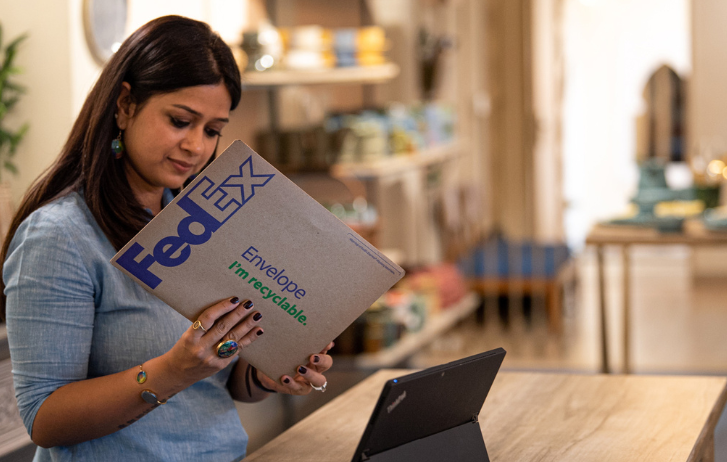
5 Key Tips To Optimize Your Reverse Logistics Strategy
By FedEx | June 25, 2024
The way you manage customer returns has a surprising impact on your bottom line. Here’s how you can develop a reverse logistics strategy that works for your e-commerce business.
- Today, more customers than ever are returning purchases and they expect a smooth returns process.
- Optimizing your reverse logistics strategy will help your business reduce time, waste, and cost from returns.
- Take the pain out of your reverse logistics management with the right partners and practices.
Here’s one big myth about returns: they’re the result of a mistake. We often think that returns happen when products don’t fit, are damaged, or don’t match customers’ expectations. But in fact, more than one in three online shoppers globally say they deliberately over-order, with the intention to return items they don’t like.
For today’s e-commerce businesses, there’s no avoiding the rise in returns from modern shoppers prioritizing choice and convenience. This makes it more important than ever to optimize your reverse logistics strategy to reduce time, waste, and cost.
How to improve the customer returns experience
Reverse logistics is the art of supply chain management for your returned goods. It encompasses all the activities needed to ship a product back from your end consumer, from returns shipping to processing. It also includes repair and refurbishing, recycling, and resale.
How well you manage your customers’ returns can make or break their experience – and ultimately impact your bottom line. Here are five tips to optimize your reverse logistics strategy:
1. Create a competitive returns policy
Your brand’s stance on returns can be a competitive differentiator. 36% of global consumers say that free returns would encourage them to buy directly from brands - a perk on par with fast and convenient delivery.
At the same time, think about balancing customer satisfaction with cost-effectiveness. The costs of shipping and managing returns add up, especially if you’re a small business.
Protect yourself from financial loss by putting limits on free returns. For example, you can restrict free returns to certain item categories, or offer free return shipping only for full-price items.
Communicate these rules to your customers with clear instructions on your website, FAQs, and social media pages. When customers understand your returns policy ahead of time, they’re more likely to have a smooth, positive experience.
2. Simplify the returns experience for customers
A return isn’t a failed sale – it’s an opportunity to win back customers. While a bad returns experience would put off 89% of consumers from going back to the same retailer, 97% would shop there again if the returns experience was positive.
You can make the returns process hassle-free for your customers with a few easy tweaks. Provide pre-printed address labels and pre-paid postage stickers that customers can simply paste onto their packages. FedEx Global Returns enables you to create return labels with your outbound shipments in three different forms: printed, email, and editable.
Next, use reusable packaging that customers can easily repack their purchase in. This makes your returns process more eco-friendly too.
Finally, enable your customers to track their returns for peace of mind. For instance, FedEx Global Returns links the return to your original shipment for easy tracking, making it straightforward for both you and your customers to track it. This transparency assures customers that they have received their refunds.
3. Tap into technology to manage returns efficiently
With return rates on the rise, brands are turning to technology to save time and cost. Nearly seven in 10 APAC retailers say they plan to deploy reverse logistics technology by 2026 for better supply chain management.
Setting up an inventory management system can help you track and sort returned products efficiently. Look for software that can analyze returns and offer insights on whether a return needs to be restocked, repaired, or disposed of. It should also provide real-time inventory tracking and customizable workflows.
Automation helps your returns transit to the right destination as quickly as possible, preventing a backlog and optimizing warehouse space.
4. Collect insights from your returns
Not only do returns put a strain on your bottom line and supply chain, they increase your carbon footprint as well. It’s worth making an effort to discover the root causes of your returns to reduce sales losses. For starters, include a feedback survey in your returns form. Encourage customers to give their reasons for returning an item, as well as suggestions on how you can improve.
Let’s say a few customers complain that the color of a garment doesn’t match what’s shown on your website. This may be your cue to prioritize high-quality product photos that give customers an accurate idea of what they’re buying.



For more data-driven insights, tap into returns analytics software or an inventory management system with built-in analytics. These solutions can help you identify patterns in customer behavior, uncover return trends across product groupings, and take preventive action.
For example, if you notice that one product grouping consistently has higher return rates than others, you can consider tightening your returns policies for that category – or shifting away from that type of product over time.
5. Explore sustainable options for returned products
There are many ways to add value from your returns, even if you can’t resell the item. Adopting sustainable practices in your reverse logistics helps you reduce waste – and improves your reputation as a responsible brand.
If an item can’t be resold, think about how you can resell parts or repurpose them into something new. You can partner with local sustainability partners or logistics providers to find novel ways to recycle your products and packaging.
Need inspiration? At FedEx, we aim to find creative ways to minimize waste. When old uniforms worn by our couriers began piling up, FedEx Thailand collaborated with a local upcycling business to recycle them into new FedEx caps. In the Philippines, we partnered with a social enterprise to turn old uniforms into sustainable gifts.
Transform your returns into opportunities
With more customers than ever expecting smooth returns, your reverse logistics strategy can make all the difference. Take the pain out of returns management by leaning on your logistics provider. Shipping support helps you tackle logistical hurdles and provides the seamless customer experience that will have buyers coming back.
Find out more about FedEx Global Returns here.
SHARE THIS STORY
- How To Ship A Giant Panda
- How To Make Freight Shipments Work For Your Small Business
- The Rise Of Intra-Asia Trade: Opportunities In The China-Southeast Asia Corridor
- Southeast Asia: The Next Manufacturing Powerhouse?
- 8 Most Unusual Shipments In The History Of FedEx
- Where Do Old Planes Go When They Retire?
Sign up now and save on your shipping rates!
Sign up now and earn discounts by shipping instantly with FedEx Ship ManagerTM at fedex.com.
Recommended For You

Small Businesses Are Hyper Personalizing Delivery
Delivery is becoming hyper-personalized – transforming how Asia’s entrepreneurs and small businesses grow, connect and compete globally.
Read More
Why E-Commerce Should Embrace The Circular Economy
Natasha Parmanand of FedEx explores how reverse logistics and the circular economy are essential for e-commerce companies with sustainability goals.
Read More
How To Drive E-Commerce Sales By Offering Discounts
E-commerce discount codes, flash sales and loyalty programs are common discount strategies for growing online customers. We share tips for e-tailers.
Read More

